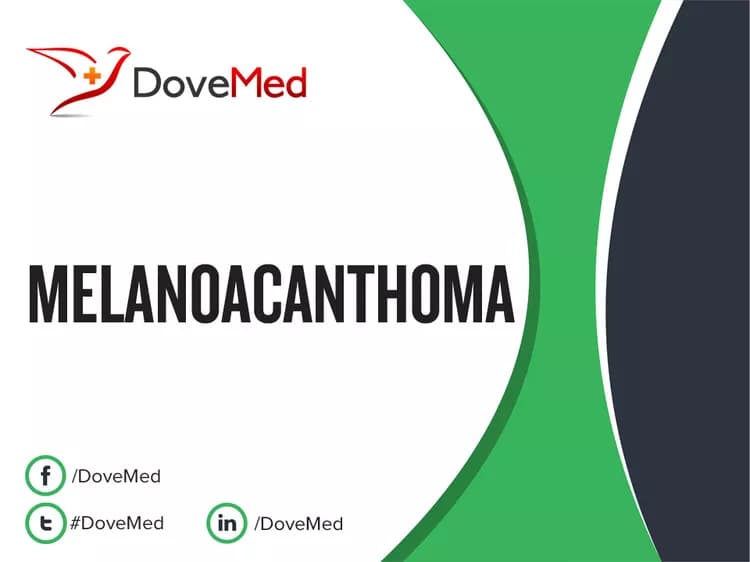What are the other Names for this Condition? (Also known as/Synonyms)
- Cutaneous Melanoacanthoma
- Melanoacanthosis of Skin
- Pigmented Seborrheic Keratosis
What is Melanoacanthoma? (Definition/Background Information)
- Melanoacanthoma is a rare benign tumor of the sebaceous gland on skin. The tumor is darkly-pigmented and can often be mistaken for melanoma (a malignant skin tumor). It is also known as Pigmented Seborrheic Keratosis and is a variant of Seborrheic Keratosis
- They are associated with itching and may ulcerate and bleed due to intense scratching. Melanoacanthoma is generally observed in middle-aged and older adults, especially in those who have a lighter-skin
- The cause of development of the condition is unknown, though the risk factors for Melanoacanthoma include exposure to sunlight and ultraviolet (UV) light
- Melanoacanthomas are often present on the trunk (chest and back). Since, these pigmented tumors resemble melanoma of skin, they are frequently biopsied to ensure a definitive diagnosis
- A treatment of Melanoacanthoma may be undertaken, if they present cosmetic concerns to the individual. In such cases, a simple surgical excision is sufficient treatment. The prognosis is excellent on removal of the tumor
Who gets Melanoacanthoma? (Age and Sex Distribution)
- Melanoacanthoma is commonly seen in middle-aged and elderly adults; the incidence may increase with age
- It is observed in both men and women
- This condition is observed worldwide across all racial and ethnic groups; however, lighter-skinned individuals (especially Caucasians) are more prone to Melanoacanthomas than darker-skinned individuals (such as Asians, Africans, etc.)
What are the Risk Factors for Melanoacanthoma? (Predisposing Factors)
The risk factors for Melanoacanthoma include:
- Exposure to sunlight and UV light
- Skin tanning (use of tanning beds)
- Caucasians are more vulnerable compared to other darker-toned individuals
It is important to note that having a risk factor does not mean that one will get the condition. A risk factor increases ones chances of getting a condition compared to an individual without the risk factors. Some risk factors are more important than others.
Also, not having a risk factor does not mean that an individual will not get the condition. It is always important to discuss the effect of risk factors with your healthcare provider.
What are the Causes of Melanoacanthoma? (Etiology)
The exact cause and development of Melanoacanthoma is unknown, but it seems to be influenced by exposure to sunlight.
What are the Signs and Symptoms of Melanoacanthoma?
In most cases, Melanoacanthoma does not present any signs and symptoms. However, the following features may be noted:
- They occur as single or multiple tiny skin overgrowths that are observed on the chest and back
- They are slow-growing tumors that may range in size from a few mm to up to 3 cm
- Typically, the tumor has a “stuck on the skin” appearance
- These benign nodules are darkly-pigmented and no malignancy occurs in them; however, they are frequently mistaken for melanoma of skin
- Melanoacanthoma is associated with itching, which can lead to constant scratching. This can result in inflammation and bleeding
How is Melanoacanthoma Diagnosed?
A diagnosis of Melanoacanthoma may involve the following procedures and tests:
- Complete physical examination with evaluation of medical history
- Dermoscopy: It is a diagnostic tool where a dermatologist examines the skin using a special magnified lens
- Wood’s lamp examination: In this procedure, the healthcare provider examines the skin using ultraviolet light. It is performed to examine the change in skin pigmentation
- Skin biopsy: A skin biopsy is performed and sent to a laboratory for a pathological examination. The pathologist examines the biopsy under a microscope. After putting together clinical findings, special studies on tissues (if needed) and with microscope findings, the pathologist arrives at a definitive diagnosis
Note: The diagnosis of Melanoacanthoma need not involve a biopsy. However, since there is a strong suspicion of melanoma, the healthcare provider may recommend a biopsy.
Many clinical conditions may have similar signs and symptoms. Your healthcare provider may perform additional tests to rule out other clinical conditions to arrive at a definitive diagnosis.
What are the possible Complications of Melanoacanthoma?
No significant complications generally arise from Melanoacanthoma; however:
- These skin growths may present cosmetic concerns, in which case a surgery may be proposed
- If they are traumatized, severe pain and bleeding with ulceration may occur
- Bleeding and ulceration can cause secondary infection due to bacteria or fungi
How is Melanoacanthoma Treated?
Melanoacanthoma may not require any treatment in a majority of cases. However, in case they present cosmetic issues in the individual, they may be removed.
- The healthcare provider may chose to regularly monitor the tumor, if they are asymptomatic. A ‘wait and watch’ approach may be adopted
- A complete surgical excision can result in a cure
- Follow-up care with regular screening and check-ups are important
How can Melanoacanthoma be Prevented?
- Current medical research has not established a definitive way to prevent the formation of Melanoacanthoma
- However, overexposure to sun’s rays and UV light should be avoided
What is the Prognosis of Melanoacanthoma? (Outcomes/Resolutions)
- The prognosis of Melanoacanthoma is excellent on its complete excision and removal
- Since, these are benign tumors, the prognosis is excellent, even if no treatment is provided and only periodic observation is maintained
Additional and Relevant Useful Information for Melanoacanthoma:
- Melanoacanthoma is not an infectious condition; they do not spread from one individual to another
- There is no definitive proof that consuming certain foods influence its development
Related Articles
Test Your Knowledge
Asked by users
Related Centers
Related Specialties
Related Physicians
Related Procedures
Related Resources
Join DoveHubs
and connect with fellow professionals


0 Comments
Please log in to post a comment.